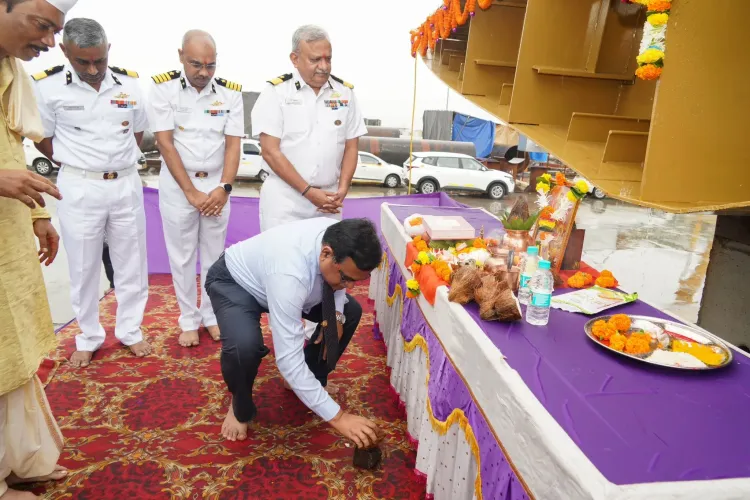Has the Keel for India's First AI-Integrated Offshore Patrol Vessel Been Laid?

Synopsis
Key Takeaways
- Keel-laying ceremony signifies the start of ship construction.
- First of six Next Generation Offshore Patrol Vessels laid down.
- Incorporates advanced AI technology for operational efficiency.
- 100% indigenous design and development.
- Expected delivery of the first vessel in 41 months.
Mumbai, July 22 (NationPress) In a significant advancement for India’s maritime security and self-reliance in shipbuilding, the Indian Coast Guard (ICG) celebrated the keel-laying of Yard 16401 - the first of six Next Generation Offshore Patrol Vessels (NGOPVs) - at Mazagon Dock Shipbuilders Ltd (MDL), Mumbai, on Tuesday.
The keel-laying ceremony is a vital milestone in ship construction that signifies the official commencement of a vessel's building process.
This event was attended by Deputy Inspector General RH Nandodkar, Chief Staff Officer (Tech) at ICG Regional Headquarters (North West), along with MDL’s Executive Director (Ship Building) A Vinod and other senior officials, as stated in the official announcement.
The construction of the NGOPVs is being undertaken under a ₹1,614 crore contract that was signed on December 20, 2023, between MDL and the Ministry of Defence, as per the statement.
What distinguishes these vessels is their incorporation of advanced technologies. They will be equipped with AI-driven predictive maintenance systems for real-time diagnostics, remote-operated drones for aerial surveillance, an Integrated Bridge System (IBS) for cohesive navigation control, and an Integrated Platform Management System (IPMS) to enhance on-board operations. These technological advancements are expected to alleviate crew workload and boost mission efficiency.
Classified under the Buy (Indian-IDDM) category, these vessels are entirely indigenously designed, developed, and manufactured, embodying the government’s “Aatmanirbhar Bharat” initiative.
Four of the six vessels will replace older OPVs, while the other two will bolster the ICG fleet. Each vessel, measuring 117 meters in length, will achieve a top speed of 23 knots and possess an operational range of 5,000 nautical miles.
Designed to accommodate 11 officers and 110 personnel, the NGOPVs are crafted for multi-role missions that include maritime surveillance, anti-smuggling, anti-piracy, search and rescue operations, and pollution response.
The keel-laying ceremony represents the official initiation of hull construction and is a traditional landmark in naval shipbuilding. The first vessel is anticipated to be delivered within 41 months, with subsequent vessels following every five months.
As India enhances its maritime presence in the Indian Ocean Region, the NGOPVs will act as long-range protectors, fortifying the Coast Guard’s capability to safeguard national interests over extensive ocean areas.
This project is also set to invigorate domestic manufacturing, create job opportunities, and enhance strategic independence in defense production.







